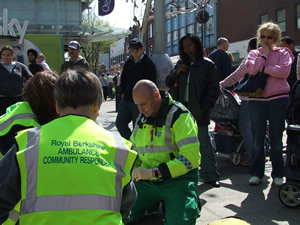Immediate Life Support (ILS) will keep your First Aid training up to date and give you the skills to manage patients in cardiac arrest before a cardiac arrest team arrives at the Practice.
Immediate Life Support was developed by Resuscitation Council UK for healthcare professionals who may have to act as the first responder in an emergency, giving them the skills to manage patients in cardiac arrest before a cardiac arrest team arrives.
It trains healthcare personnel in causes and prevention of cardiopulmonary arrest, the ABCDE approach, initial resuscitation and defibrillation (manual and/or AED), and simple airway management.
We will need access to your Oxygen kit and emergency drugs kit to discuss the contents and go over their use (we won’t actually use anything).
This course is for Healthcare professionals such as the following:
- Doctors – hospital and community
- Medical students
- Nurses – Hospital and community
- Nursing students
- Midwives
- ODPs
- Cardiac Technicians
- Occupational Therapists
- Physiotherapists
- Radiographers
- Resuscitation Training Officers
- Dentists and Dental Nurses
- Ambulance Technicians / Paramedics
- Healthcare Assistants
The course is 6 hours / 1 day long and the certificate is valid for 1 year.
All our first aid courses fully meet the UK and European Resuscitation Council Guidelines 2015 as per the HSE requirements.
Certification
All Certificates issued are in electronic (PDF) format. They will be sent to the person (or organisation) that organised the Booking in order for them to be distributed to the student(s).
Course Duration (excluding breaks)
6 hours
Maximum students per course
12
Minimum age
16
Individual Price
£98 + VAT
Group price
£800 + VAT
Group Pricing assumes that the Client provides a suitable training venue. Click here for venue requirements
Whilst we try and maintain a fixed cost for our courses, our prices may be subject to an additional fuel charge if your location is a distance away from our nearest trainer to you.
There is a £50 supplement per day if that day is a Sunday or Bank Holiday.
All prices exclude VAT at the current rate of 20%.
Syllabus
1. Understand basic life support requirements
- 1.1 Describe the principles that underpin basic life support
- 1.2 Explain the circumstances under which resuscitation is performed
- 1.3 Explain why early intervention is necessary
- 1.4 Describe different types of cardiopulmonary arrest
- 1.5 Understand what pulse oximetry is and why it is important in assessing a patient
- 1.6 Explain the ABCDE approach to patient care
- 1.7 Explain how to check a patients pulse, temperature, blood pressure and other observations.
- 1.8 Explain what Hypoxia is and how it affects the patient
- 1.9 Explain the difference between heart attack, angina and sudden cardiac arrest
2. Be able to demonstrate basic life support techniques and automated external defibrillator use in line with current national guidelines
- 2.1 Demonstrate cardiopulmonary resuscitation
- 2.2 Demonstrate compression only resuscitation
- 2.3 Demonstrate the use of resuscitation barrier devices
- 2.4 Demonstrate how to manage a choking adult, child and infant
- 2.5 Demonstrate the use of an automated external defibrillator
- 2.6 Describe the differences when using an automated external defibrillator on a child and on an adult
- 2.8 Explain why suction is used to maintain the airway
- 2.9 Explain how an Oropharyngeal airway is used and why they benefit the airway
- 2.9 Explain the requirements of a do not resuscitate order
- 2.10 Demonstrate correct use of a bag valve mask
3. Be able to demonstrate post-resuscitation procedures
- 3.1 Demonstrate how to place a casualty in the recovery position
- 3.2 Identify the risks when placing a casualty in the recovery position
- 3.3 Describe handover and reporting procedures
- 3.4 Explain the correct administration of Oxygen on a patient
- 3.5 Understand the correct assembly, disassembly and storage of an Oxygen kit.
- 3.6 Explain the different types of an Oxygen mask and when you would use them.
4. Be able to carry out basic user maintenance and troubleshoot problems with an automated external defibrillator
- 4.1 Identify when a defibrillator battery requires changing
- 4.2 Identify when electrode pads need replacing
- 4.3 Demonstrate how to troubleshoot problems if the automated external defibrillator does not function correctly
5. Understand the safe use of an automated external defibrillator
- 5.1 Describe the safety considerations when using AEDs
6. Understand medical emergencies
- 6.1 Describe the following medical emergencies and the treatment required for the following:
– Asthma
– Hyperventilation
– Anaphylactic shock
– Diabetes
– Seizures and Epilepsy
– Sepsis


